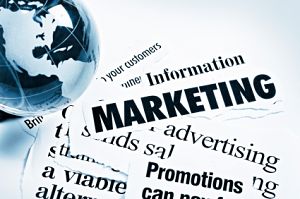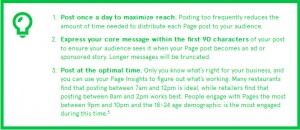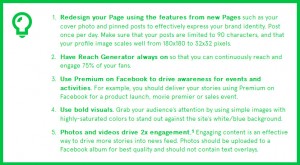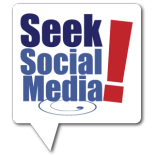Timeline Isn’t the Only Change in Facebook’s New Marketing Solutions
 You’ve surely heard the buzz of the past little while! Facebook has rolled out Timeline for Pages! Some Page owners rushed to convert, some held off until it became mandatory on March 30. Some are still confused about what Timeline means to their Pages. While Timeline is the most visible piece of the ‘new marketing solutions’ that were announced at the end of February, it’s not the only piece – even though that’s what we’ve heard the most about. Let’s take a look at the other aspects of the new marketing solutions and what they mean to Facebook Pages, especially those of small businesses. There are many changes to the Pages themselves, so we’ll start there.
You’ve surely heard the buzz of the past little while! Facebook has rolled out Timeline for Pages! Some Page owners rushed to convert, some held off until it became mandatory on March 30. Some are still confused about what Timeline means to their Pages. While Timeline is the most visible piece of the ‘new marketing solutions’ that were announced at the end of February, it’s not the only piece – even though that’s what we’ve heard the most about. Let’s take a look at the other aspects of the new marketing solutions and what they mean to Facebook Pages, especially those of small businesses. There are many changes to the Pages themselves, so we’ll start there.
Changes to Pages
The Page is a brand’s mission control, according to Facebook. They describe Pages as the “most customizable marketing canvas ever created” connecting your brand to people in the ways that matter to them (that’s a very important phrase…in the ways that matter to them). Brand Pages aren’t new, but they’re getting some new features:
- Cover photo (an 851 x 315 pixel photo like the ones rolled out to personal profiles a few months ago – minimum 399 pix wide) and Timeline for Pages
- Ads and Sponsored Stories (personalized ads) will now be available on Facebook’s mobile platform
- Tabs, such as Welcome/Landing page, are replaced with Views and Apps. Some were upset that this took away the option of a fangate (a landing page that encourages the user to “like” a page to see the content), but Facebook answered this, saying brands can still drive traffic to these pages through ads. (Oh how very sly, Facebook!)
- Posts can now be pinned to the top of a Page for 7 days to highlight important news
- Posts that are less engaging can now be hidden
- Photos in posts are larger to encourage engagement
- Brand milestones can now be represented on the timeline
- Fans can now send private messages to brands. At present, brands cannot initiate a private message to a fan.
These changes are huge, but really, they are just the beginning.
Reach Generator
Currently brands reach only about 16% of fans with their posts – not very effective when trying to connect with and encourage fan engagement. This is a new ‘always on’ tool guarantees brands will reach 75% of their fans each month and 50% of fans each week. WOW! What they don’t mention (although implied in small print) is that this ‘always on’ tool is only available to brands that run sponsored story advertising. Oops. While brands should run ads and sponsored stories to grow their communities, it shouldn’t be a requirement in order to be seen in fans’ news feeds. However, for those brands that do run ads, this is a great new tool. Fans can’t engage with brands if they don’t see their posts, so getting seen by fans is a top priority. Questions remain, though, such as what happens to reach as soon as the ad campaign ends? Does this mean that brands must run ads continually just to be seen? What happens to local brands and small businesses who don’t have a large marketing budget? Are they stuck with only 16% reach? These questions will only be answered over time. Facebook has provided some posting guidelines for Reach Generator as seen below:
 Premium on Facebook
Premium on Facebook
Premium on Facebook takes a brands’ Page posts and places them in the most impactful areas of the site, such as the right-hand side of the homepage (news feed), in the news feed on the homepage and mobile, and, optionally, on the log-out page. Brands must contact a Facebook marketing rep to avail themselves of this product and the ads are more expensive, but will undoubtedly bring greater reach and engagement than their less expensive cousins.
Ads will show on the right-hand side of news freed for those not connected to the brand, in the news feed of fans as sponsored stories. These placements bring 5x-10x more engagement, are 80% more likely to be remembered and can leverage ROIs of 3x or greater, Facebook claims. Premium is best used for product launches, special events, and sales. A guidelines snapshot for Premium is shown below:
 Improved Insights
Improved Insights
Insights is Facebook’s in-site analytics tool that has typically been less than insightful. The problem is that the data were three to four days behind, making it difficult to utilize it effectively. The new Insights are real-time which will make them much more useful for marketers.
Admin Levels
Also announced were five levels of access for Page admins that were slated to be released in late March, but have yet to be rolled out. Thus far, Facebook has announced three levels: full access, publishing-only access, and insights access, but haven’t revealed the other two levels.
Conclusions
These changes, while not perfect for the smallest of marketers on the network, show that Facebook realizes that they must take marketers’ needs into consideration when developing new features. Past roll outs haven’t always reflected such consideration. One thing is clear – Facebook wants ad revenue. To prove it, they’ve put in place features that will make it worth your while to spend your marketing dollars with them. Still, the question remains as to how small businesses with small marketing budgets will fare in this new Facebook environment. At least the marketing dollars they can afford will prove more effective.
Facebook has released a resource library for brands including overall best practices, best practices by industry, and white papers on brand building and organizational design. These resources can be found here: Facebook New Marketing Solutions Guides. Watch all of the videos of the breakout session of the Facebook Marketing Conference here.
What are your thoughts about these changes and how they will affect Facebook marketing? Let me know in the comments!
Carole Billingsley (@YouSeekSocial) is a social media consultant and trainer. Combining her social media expertise with her decades of experience in entertainment and education, Carole founded Seek Social Media in 2011. She is known for her ability to make technical and social media topics easy to understand for even the least tech-savvy business owner. Specialty areas: social media, customer experience, digital presence, crisis management.


